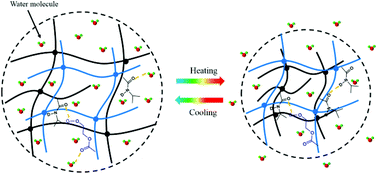The unusual volume phase transition behavior of the poly(N-isopropylacrylamide)–poly(2-hydroxyethyl methacrylate) interpenetrating polymer network microgel: different roles in different stages†
Abstract
Dynamic thermal phase transition behavior of a well-defined poly(N-isopropylacrylamide)–poly(2-hydroxyethyl methacrylate) (PNIPAM–PHEMA) interpenetrating polymer network (IPN) microgel in D2O synthesized by two-step precipitation polymerization was studied by means of IR spectroscopy in combination with the perturbation correlation moving window (PCMW) technique and two-dimensional correlation spectroscopy (2Dcos) analysis. Due to the hydrophobic and non-thermo-responsive properties of PHEMA and the special IPN structure, the IPN microgel exhibited an unusual thermally induced collapse process. The introduction of PHEMA would lower the volume phase transition temperature (VPTT) and the volume phase transition degree. 2Dcos was finally employed to discern the sequence order of all the group motion during heating and cooling processes. PHEMA plays different roles in different stages during the volume phase transition. Additionally, as PHEMA exhibits only a slight response to temperature, it would provide the PNIPAM–PHEMA IPN microgel with good reversibility.


 Please wait while we load your content...
Please wait while we load your content...